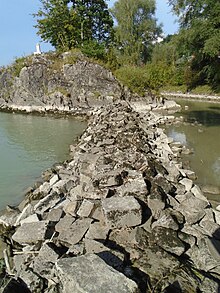Dam

The Leitdamm is one of the so-called parallel works or longitudinal works in hydraulic engineering . It is used to permanently or temporarily change the existing current either to protect certain (bank) areas from erosion or to concentrate the current in certain (fairway) areas with the desired erosion or self-clearing power.
Design features
Basically, a straight line should prevent the development of turbulence. The upper edge is selected according to the respective requirements and is usually in the area of the mean water. In the tidal area , the upper edge is usually visible at low tide , outside the tidal area it is usually always below the waterline. Guiding dams are often built as protective structures for the construction of other hydraulic structures such as dams , dams , ports or even dykes . After completion of the actual structure, the dam will be flooded and can be used again for later work or repairs. Guiding dams are an alternative to groynes . They are more expensive to build and maintain, but ensure a more even flow with less turbulence. In contrast to groynes, subsequent changes of position are almost impossible.
The construction method and the choice of building material depend on the stresses caused by currents and swell. Basically, the stronger the attacking forces, the coarser the building material and its fastening. As a rule, at least the side exposed to the flow is covered with a thick bed of stones if the entire cross-section does not consist of stones. Otherwise gravel can also be built into the core. With fine-grained subsoil, the underside is secured with geotextile or sink mats (wood) to protect against subsidence.
Guiding embankments lying under water are marked for shipping by means of signs that show the direction of the embankment with two arrows, or navigation marks for shipping safety.
Effects
Regardless of whether a dam is built to protect the rear area or to increase flow in the front area, it always has both effects. This means sedimentation (landfall) on the back (bank side) and erosion on the front (water side). Usually only one of the two effects is desired. The Kugelbake guide dam in front of Cuxhaven, for example, is intended to ensure the reliable position of the fairways for shipping in front of the dam and, on the other hand, promotes undesirable sedimentation between the dam and the bank. The Watt is sedimented always higher between dam and beach since it was built 45 years ago and the water become correspondingly flat. In front of the dam, on the other hand, erosion has increased beyond the desired effect and threatens the guide dam from below through scouring . Guide dams promote the 'steepening' in flowing waters , that is, landings and thus loss of shallow water zones and deepening of deep channels. The picture shows the high mudflats south of the Kugelbake dam and the hopper excavator before being dumped into the scour directly in front of the dam.
See also
Web links
- BAW Colloquium 2003 Lecture 1 by Dipl. Ozeanogr. Marcus J. Boehlich, pp. 87 - 90, BAW Colloquium November 13, 2003 (PDF file; 4.08 MB)


